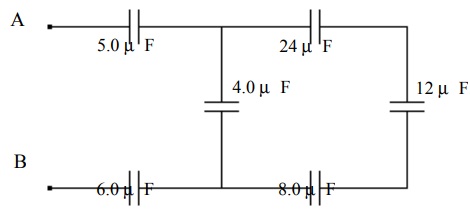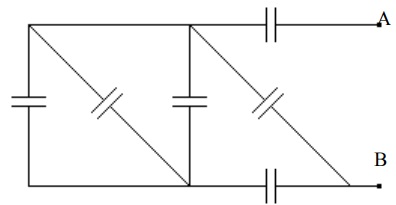Assignment:
Problems:
1) A capacitor has a capacitance of 2.5 x 10-8 F. The capacitor is charged by removing electrons from one plate and placing them on the other plate. The process continues until the potential difference between the plates is 450 V. How many electrons have been transferred in order to accomplish this?
2)A parallel plate capacitor is filled with a dielectric of ruby mica. The area of each plate is 3.8 m2. The capacitor stores 2.7µ C of charge if
you apply a 1.5 V battery across the plates. What is the plate separation?
3) The plates of a capacitor are separated by a distance of 11 mm. Each plate contains a charge of 19 µ C. The electric field between the
plates is 640 V/m. What is the capacitance of the capacitor?
4)A "air" capacitor has an area of 2 cm2 with plates that are separated by a distance of 2 mm. How much charge does this capacitor store
when it is connected to 6 V battery?
5) The flash on a high-tech camera contains a capacitor of 750 µ F. The battery in the camera supplies 330 V.
(a) Determine the energy that is used to produce the flash.
(b) Assuming that the flash lasts for 5 ms, find the power of the flash.
6) The potential difference between the plates of a capacitor is 400 V.
(a) If the spacing between the plates is doubled without altering the charge on the plates, what is the new potential difference?
(b) If the plate spacing is double while the voltage is held constant, by what factor will the charge change?
7) Three capacitors are connected in series. Their values are 3 µ F, 5 µ F, and 8 µ F. The capacitors are connected to a battery of 25 V.
a) Draw a circuit diagram.
b) Find the equivalent capacitance.
c) Find the charge coming off of the battery.
d) Using a Q-C-V chart find the Q and V values for each capacitor.
8)Three capacitors are connected in parallel. Their values are 3 µ F, 5 µ F, and 8 µ F. The capacitors are connected to a battery of 25 V.
a) Draw a circuit diagram.
b) Find the equivalent capacitance.
c) Find the charge coming off of the battery.
d) Using a Q-C-V chart find the Q and V values for each capacitor.
9) Determine the equivalent capacitance between points A and B for the capacitors shown in the circuit below.

10) Determine the equivalent capacitance between points A and B for the capacitors shown in the circuit below. All of the capacitors have
a value of 10 µ F.
